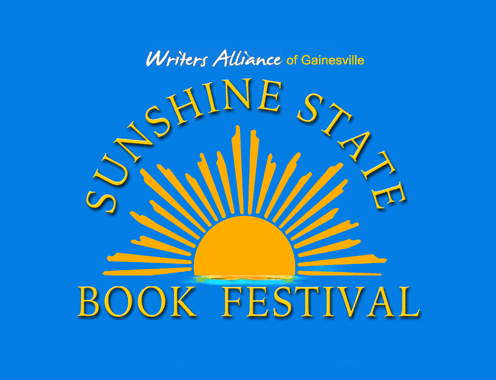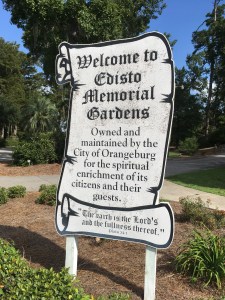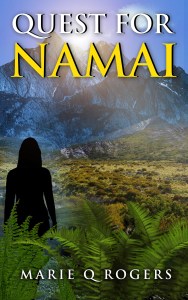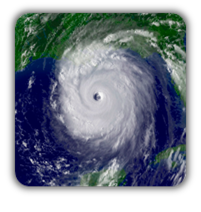As part of our genealogical research, my sister Sue and I visited old cemeteries looking for dead relatives. Often we’d find headstones of other people’s relatives engraved with a husband’s dates of birth and death, but only the birthdate of his wife. Where could the good woman be? Still alive? Are there scores of 150 year old widows still walking around out there? That nugget became the impetus of this story. Then I tossed in a character, Jefferson, who is out of his element.
“The Family Plot” was previously published in the 2023 Eckerd Review. Read and enjoy!
Jefferson suspected he was in the wrong grave. All he remembered of that last moment of his life was uproar, violence, and confusion. No pain. No time for that. Afterward, a soft, velvety darkness allowed him to sleep.
What happened at the time of death no longer mattered, but afterward, something had gone awry. Even before he heard all those white voices whispering around him, he knew he was not in the right place. A foggy perception lingered, of people crying, “Mama” and “Cheryl.” A male voice demanded, “What do you mean I can’t see her?” Another voice murmured a reply, but the only words he caught were, “Sorry, Mr. Blackthorne…burned beyond all recognition.” Who were all those people? It wasn’t important, as long as he could rest. The hazy voices faded. Hymns lulled Jefferson to sleep. He could have slept forever.
He could have slept forever, but a shrill voice harrumphed, “Well, I never! This just isn’t right. His kind doesn’t belong here.”
“Hush, Aunt Adelaide,” a mild one enjoined. “Times have changed. He has as much right to be here as anybody.”
“But this is ourah family plot! That space was reserved for one of ourah people. You heard what Cheryl’s husband said. He wants to be laid beside that grave when his time comes. Besides, the colored cemetery is…well, I’m not sure where it is. I never been to that part of town.”
Lord have mercy! Jefferson began to get an inkling of what had gone wrong, and it was terribly wrong. How could this have happened?
Aunt Adelaide harrumphed again.
Jefferson could take no more. “Now you hold on there just one minute. How do you think I feel about all this? I didn’t ask to be put here with all you crackers. I’m supposed to be in my family’s plot!”
“Well, of all the…”
“Hush!” insisted the niece. “There’s nothing any of us can do about it.”
Apparently, Aunt Adelaide couldn’t think of a comeback.
The niece continued, “Think about poor Cheryl. What happened to her? She must be buried somewhere else. They may have put her where he should be.”
If the dead could groan, that’s what Aunt Adelaide did. “To think that one of my blood is interred somewhere with all those coloreds! It is the Time of the Apocalypse! The End of the World is at hand!”
“Hush, Mother,” came a third voice. “You’ve been saying that for the last fifty years.”
Jefferson ignored Aunt Adelaide. If he’d been put here, where Cheryl was supposed to be, then where was Cheryl, whoever she was? If she were indeed trying to rest in his intended place, what were his own deceased relatives saying about her? If the dead could laugh, that’s what Jefferson did. But he felt tired. He wasted no more time worrying about Cheryl, or his relatives, or their problems. Nothing prevented him from sleeping now.
Except a moldy old voice which crept around his elbow. “Son, have you any news of my wife? Her name is Edith Owens.”
“No, sir. That name don’t sound familiar.”
“You see, she’s supposed to rest beside me when she dies. It says so on my headstone, ‘Edith Owens, Faithful Wife and Mother.’”
Still another voice intervened, “Grandpa Owens, you’ve been askin’ that of ev’rah soul what’s come here for the past ninety years. Nobody’s seen her.”
“But somebody’s got to of seen her. Maybe she’s in a nursing home. She’d be pretty old by now.”
“Yeah, try 160 years old, more or less. Grandpa, people just don’t live that long. She’s buried somewhere else.”
“Oh, no. Her place is here, beside me. Her name is on my headstone.”
“And on somebody else’s, too,” proclaimed a male voice. “Maybe more than one. She was on her third husband when I came here.”
“But that doesn’t matter. I was her first. She’s supposed to come here when she passes. Nobody’s told me she died.”
Another voice spoke with annoyance, “You should be asking somewhere else if you want to know where she ended up. Her descendants are scattered all over the country.”
“Well, I believe she’s still alive. And I’ll wait for her here, until she comes. If it takes forever,” Grandpa’s voice grew sleepy. With an added, “I’ll just wait,” it faded away.
Yes, it will be forever, Jefferson thought. And you’ll wait, all right. You’re not about to go anywhere. Neither am I, it seems. Another thought troubled him—who would someday be laid beside him? Cheryl’s husband? A white man? If the dead could shudder, that’s what Jefferson did.
They left him alone for a while. Jefferson slept. How long? Time meant nothing. Do the dead dream? He thought they were digging him up. Finally! They’d discovered their mistake! No, it was only a minor disturbance. Then it went away.
There followed a period of peace and quiet. Then pandemonium struck again. Do the dead have nightmares? The ground rumbled and heaved. What—an earthquake? Aunt Adelaide’s Apocalypse? No, it was only a backhoe digging a new grave nearby. Once the turmoil subsided, Jefferson heard Aunt Adelaide go through the litany of generations to figure out where the new inhabitant fit in. It was one Amy Blackthorne, Cheryl’s daughter.
Amy’s deceased clan remained respectfully silent until she had time to orient herself. The first person she spoke to was Jefferson. “Mama?”
“No, she ain’t here.”
“What do you mean she ain’t here? She’s supposed to be! Daddy told me they buried her in the family plot. Unless—oh, no! I hope they didn’t put me someplace else!”
“No,” Aunt Adelaide huffed. “You’re in the right place. They put your mama in the wrong place.”
“No they didn’t. Daddy showed me pictures of the grave. I gave him fifty dollars to buy flowers for me. He put them on the grave after they put the headstone there. He took a picture of it and showed it to me. Mama’s name was on it.”
So that’s what interrupted Jefferson’s rest, when they set the headstone. What was written on that headstone? Cheryl Blackthorne’s name? Why didn’t Amy go to her mother’s funeral? And why hadn’t she put the flowers on the grave herself? What kind of ungrateful child was she?
“Excuse me,” he asked, “why didn’t you go to your mama’s funeral?”
“Who are you?”
“I am Jefferson Lincoln Jones.”
“What are you doing here?”
“That’s what I’d like to know myself.”
“What have you done with my mama?”
“I ain’t done nuthin’ with yore mama. I suspect she’s in my family’s plot. With my name on her tombstone.”
“Oh, God! No!” If the dead could cry, that’s what Amy did. “How could this happen?”
Aunt Adelaide’s niece spoke up, “We were hoping you could tell us. What funeral home did you use? Maybe they switched caskets.”
That was too much for Jefferson. “We have our own funeral home, thank you very much. My uncle runs it. And he don’t switch caskets.”
The niece resumed, “Amy, didn’t you view your mother’s body?”
“No. I couldn’t go to the funeral. I was in the hospital.”
“What about your daddy? And the rest of the family?”
“They wouldn’t let them see her. They said she’d been burnt to a crisp.”
“How on earth did she die?”
“The fireworks store blew up.”
Now Jefferson remembered. The Fourth of July. His family had dispatched him to buy fireworks for their celebration. He was standing in line with his purchases. The woman ahead of him stepped up to the register and put her purse on the counter. He took out his wallet. And that was it.
“Amy, how did they identify the body?”
“They said they found her purse.”
How did he end up with a woman’s purse? And what became of his wallet? Couldn’t those idiots at the morgue tell the difference between a white woman and a black man? Even if they were “burnt to a crisp?” What about DNA? What about all that science stuff they show on TV? Oh, yeah. This county was still in the Dark Ages. Well, they always check dental records, don’t they? Then Jefferson remembered he’d never gone to a dentist.
Someone asked Amy, “How did you die?”
“I was at the store, too. I was outside in the car, waiting for Mama. I got hurt pretty bad. They took me to the hospital in a helicopter. I was in a lot of pain. For six months. Then I came here.”
The moldy old voice woke. “Have you any news of my wife? Edith Owens?”
“Who is she?”
Aunt Adelaide informed Amy, “She’d be your great-great-grandmother. That old fool thinks she’s still alive because she hasn’t been buried beside him.”
“No, I never heard of her.”
If the dead could gasp, that’s what Grandpa Owens did. “Never heard of her?”
“That’s enough, Rufus,” Aunt Adelaide said. “These young people are not taught anything about their pedigrees.”
“Pedigree, schmedigree,” sneered the male voice. “Aunt Adelaide, you won’t even acknowledge your own pedigree.”
“What do you mean?” Amy asked.
“Adelaide’s grandmother was half Cherokee. She won’t admit she ain’t pure white herself.”
If Jefferson could have chuckled, that’s what he did. “Well, maybe we’re related after all. I got Cherokee in my blood, too.”
The male voice added, “And someday, Jefferson won’t be the only black person in this plot. Amy, isn’t your cousin married to a black man?”
“That’s right. And they have children, too.”
If the dead could sniff, that’s what Aunt Adelaide did.
Once everyone in the family plot accepted the fact that Jefferson was stuck here, and Cheryl somewhere else, for all eternity, death went on. Aunt Adelaide stopped fussing, and Jefferson finally got his longed-for rest.
All in all, death could be interesting. Jefferson didn’t sleep all the time. Sometimes his neighbors sang songs and he joined them. The old and the young exchanged their stories. They even requested that Jefferson tell his. One day someone asked, “I wonder what people do in those little family graveyards that are all filled up and they never bury anybody new?”
“They probably get more rest than we do here,” someone else grumbled.
“I bet it gets boring,” another surmised. “But I worry about those people who get cremated and they scatter the ashes. What comfort do they get?”
That answer came one day when an ash blew in and settled into the soil. “Where am I?”
Someone told her and asked, “What are you doing here?”
“My ashes were supposed to be scattered on the family farm, but a gust of wind came up and I got blown all over.”
They questioned her about her death and what was going on in the world. Jefferson wished he could get news of his family. This discussion prompted exchanges between the ash and other parts of herself that had settled in diverse places, including Jefferson’s family’s cemetery. Jefferson sent a message to his deceased relatives, and to Amy’s consolation, the ash brought word from Cheryl. By now she was getting along quite well with her neighbors. But the ash had no news for Grandpa Owens.
Inevitably, the day came when a dark-skinned child joined them, and to Jefferson’s surprise, it was Aunt Adelaide who comforted the baby and dispelled his confusion.
Finally came a disturbance that Jefferson knew had to be the end of the world. Not only did the ground rumble and shake, but the coffin around him threatened to come apart.
It was not the Apocalypse, after all. As it turned out, the grave beside him was being dug. Soon, Cheryl’s husband lay beside Jefferson, who braced himself for the inevitable shock, confusion, and diatribe when the man learned that Jefferson was not his wife.
But before the poor soul had time to say anything, Grandpa Owens, shaken from his mold by the disturbance, inquired, “Son, what news have you of my wife?”







































